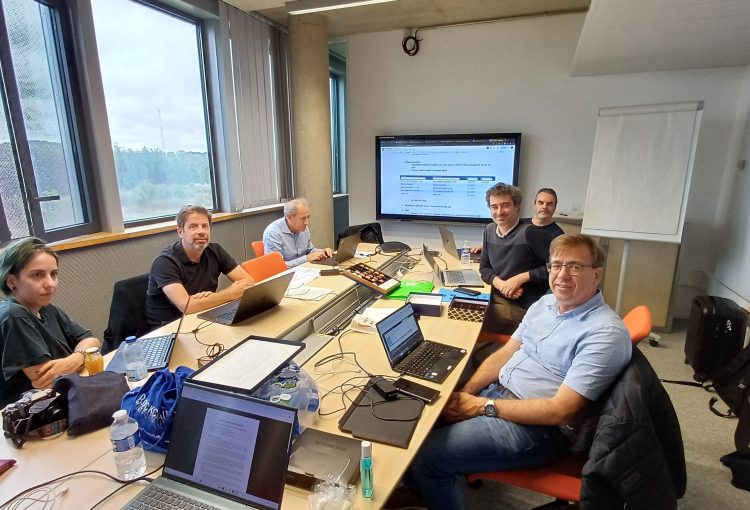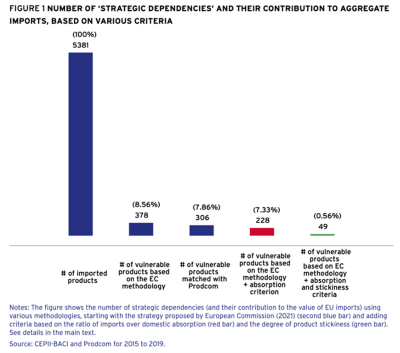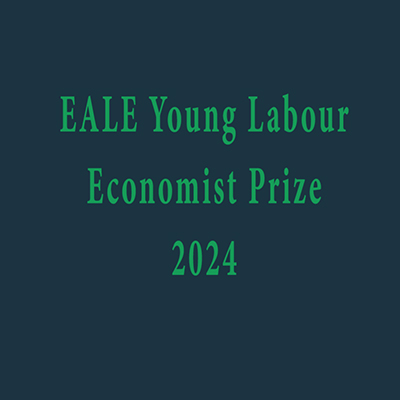27 Septembre 2024
Une tribune d’Ivaylo Petev pour Polytechnique insights
2 Octobre 2024
FairOnChain Consortium Meets at École polytechnique
On September 26, 2024, Blockchain@X Research Center, part of CREST, hosted the second in-person FairOnChain consortium meeting at the Alan Turing Building at INRIA on the École polytechnique campus.

The meeting brought together the principal investigators (PIs) and researchers involved in the FairOnChain project, an initiative focused on developing a fair and modular blockchain data infrastructure for open science and society. Participants included:
- Prof. Julien Prat, CREST, École polytechnique
- Prof. Marco Mattavelli, École Polytechnique Fédérale de Lausanne
- Prof. Arnaud Gaudinat, Haute École de Gestion de Genève
- Prof. William Knottenbelt, Imperial College London
- Christophe Lebrun, Haute École de Gestion de Genève
- Madalina Sas, Imperial College London
- Natkamon Tovanich, CREST, École polytechnique
During the meeting, the team updated the progress of ongoing work and detailed the planning for the next phase of the project. This included developments of a unified blockchain data structure and publicly accessible blockchain datasets aimed at enhancing data access, transparency, and reproducibility in blockchain research.
The team also discussed the technical work required to achieve the project goals and plans for the internal report submission to CHIST-ERA. Furthermore, they explored the possibility of upcoming publications resulting from the research within the consortium.
The meeting strengthened collaboration within this international team. Future meetings are planned for Lausanne, Switzerland, around January 2025, followed by a gathering in London, United Kingdom, in June 2025.
About FairOnChain Project

The FairOnChain Project is a pioneering European research collaboration funded by the CHIST-ERA call for Open and Reusable Research Data and Software (ORD). Running from 2023 to 2025, this two-year initiative aims to overcome the technical barriers to accessing and analyzing blockchain data, promoting enhanced transparency and reproducibility in blockchain research.
As part of this project, the FairOnChain team will contribute to the scientific community with:
- Publicly Accessible and Expandable Datasets: These will include structured, daily updated blockchain transaction data. Researchers can access raw blockchain transactions alongside enriched, community-maintained datasets in a uniform, open format, ensuring greater availability and reuse of this complex data.
- Open-Source Software Framework and Standardized APIs: This project aims to deliver a unified framework for researchers to query, annotate, and reference blockchain data effectively. Additionally, it will support the development of well-described, reusable workflows and pipelines to facilitate the exchange and replication of scientific results in line with the FAIR principles (fundability, accessibility, interoperability, and reusability) of open science.
By developing modular and scalable data infrastructure, FairOnChain aims to facilitate easier, open access to blockchain datasets, enabling researchers and society to benefit from trustworthy and reusable data for scientific discovery.
The consortium behind FairOnChain includes leading research institutions from France (École polytechnique, Institut Polytechnique de Paris), Switzerland (Haute École de Gestion de Genève, HES-SO and École Polytechnique Fédérale de Lausanne) and the United Kingdom (Imperial College London).
Each institution has received grants from its respective national research agencies to support this collaborative research project.
Pourquoi les économistes se trompent-ils (quasiment) tout le temps ?
Interview de Béatrice Cherrier pour Les Echos (23.09/2024)
Lancement de la Chaire Impact Investing
Federica Meluzzi, 2024 EALE Young Labor Economist Prize winner
CREST is proud to announce that Federica Meluzzi, a PhD candidate in Economics at CREST-GENES, has been awarded the 2024 EALE Young Labor Economist Prize.
Federica Meluzzi, PhD candidate at CREST specialized in labor economics.

Federica’s work is in labor economics at the intersection with public economics and education. Specifically, her research is on gender differences in the labor market, with a focus on how gender norms are transformed, either by public policies or with the social environment.
Federica will be going on the academic job market 2024 – 2025.
The European Association of Labor Economists and the EALE Young Labor Economist Prize.
The European Association of Labor Economists (EALE) was founded in 1989 in order to promote the advancement of knowledge in the field of labor economics in Europe and elsewhere.
The EALE Young Labor Economist Prize is awarded by the EALE to recognize outstanding research in labor economics. It is awarded to a young economist, who has authored an excellent paper presented at the annuel EALE conference. The prize aims to highlight innovative contributions to the field and support the development of young researchers in labor economics. It is considered a prestigious honor within the academic community.
For the 2024 EALE Conference, Federica presented her paper “The College Melting Pot: Peers, Culture and Women’s Job Search”.

“The College Melting Pot: Peers, Culture and Women’s Job Search”.
Today, there is strong consensus on the importance of gender norms in explaining the residual gender gaps in the labor market. However, our understanding of the drivers of gender norms, and their implications for preferences, remain lacking. Her paper, “The College Melting Pot: Peers, Culture and Women’s Job Search”, contributes to filling this gap by providing novel large-scale evidence on the effects of the social environment – specifically college classmates – as a driver of women’s early-career labor market decisions.
Using unique administrative and survey data covering all college students in Italy, this study leverages cross-cohort idiosyncratic variation in the geographical origins of peers within Master’s programs. The key finding is tat exposure to female classmates from areas with egalitarian gender norms significantly increases women’s labor supply, primarily through increased uptake of full-time jobs. The estimated peer effects are substantial, accounting for more than a third of the gender earnings gap.
Drawing on large-scale data on students’ job-search preferences and newly collected data on their beliefs, Federica shed light two main drivers of peer influence: (i) shifts in preferences for non-pecuniary job attributes, and (ii) social learning, particularly on the characteristics of the job offer distribution.
Other works.
Federica’s other works are on how the design of parental leave benefits affects households’ decisions to share parental leave, on the role of firlms in shaping the stickiness of gender norms, on the effects of pay transparency on within-firm pay premia, and on gender differences in the responsiveness to UI benefits.
Prix Nobel d’économie : comprendre les inégalités de genre face à l’emploi avec Sara Signorelli et Roland Rathelot
Elio Nimier-David & Meyer Scetbon: 2024 IP Paris Thesis Prize in economics
Welcome at CREST: Introducing our latest recruits.
Each year, CREST goes beyond its borders to find new minds to keep on offering pioneer research. This year, CREST was able to attract new talents from all around the world (Canada, France, Italy, Switzerland, UEA, UK and USA). These new recruits bring with them a wealth of knowledge, diverse experiences, and a passion for pushing the boundaries of their respective fields. New recruits is always very much appreciated by our PhD students and students from ENSAE Paris, ENSAI and École polytechnique, where they may teach as they arrive with a different background and knowledge base.
As CREST continues to produce groundbreaking research about and for society, the arrival of these scholars marks a significant milestone in our journey. Each professor brings unique expertise that will not only enhance our ongoing projects but also open new avenues for exploration and discovery.
In this article, we will introduce you to our new researchers, delve into their backgrounds, and share their specializations that will contribute to the vibrant research environment at CREST.
Economics
Laurent Bach, Visiting Professor (ESSEC)

Interests: Entrepreneurial Finance, Corporate Governance, Household Finance, Public Economics, Political Economy
Current position: Laurent is currently and Associate Professor of Finance at ESSEC Business School
Laurent completed is PhD from Paris School of Economics in 2010
Federico Di Pace, Associate Professor (ENSAI)

Interests: Monetary Economics, macro-labor, international economics and applied econometrics
Previous position: Federico was previously a Senior Economist at the Bank of England.
Experienced Senior Economist with a demonstrated history of working in the academia and central banking, Federico conducted economic research with particular focus on labor markets and its interaction with monetary policy. He has conducted academic policy pieces using applied theory and time series econometrics. Federico completed his PhD in Economics at Birkbeck College, University of London.
https://sites.google.com/site/federicodipace/home?authuser=0
Yameng Fan, Assistant Professor (ENSAI)

Interests: Macroeconomics of labor markets, political economy, market power and spatial economics.
Previous position: PhD in Economics from Universitat Pompeu Fabra.
Florian Grosset, Assistant Professor (ENSAE Paris, Institut Polytechnique de Paris)

Interests: Development and environmental economics with interests in labor and firms
Previous position: PhD in Sustainable Development from Columbia University
The first strand of his research focuses on labor and networks in lower-income countries. His work explores how individuals’ labor supply decisions are influenced by their social network members, primarily with field experiments. The second strand of Florian’s research focuses on firms’ responses to environmental changes. It combines insights from the natural sciences with applied micro-economic tools for causal identification.
Marion Leroutier, Assistant Professor (ENSAE Paris, Institut Polytechnique de Paris)

Interests: Applied Environmental Economics focusing on two major environmental issues, ambient air pollution and climate change.
Previous position: Postdoctoral fellow at the Institute for Fiscal Studies.
Marion’s research agenda has two angles. First, she investigates the societal cost of air pollution and the causal impact of climate and environmental policies, with an emphasis on health, productivity and distributional effects. In a second and more early-stage angle, Marion studies the determinants of support for green policies, in particular the role of social norms and identity.
Bertille Picard, Assistant Professor (ENSAI)

Interests: Econometrics, Machine Learning applied to policy evaluation and inequalities.
Previous position: PhD in Economics at Aix-Marseille School of Economics (AMSE)
Yuki Tamura, Assistant Professor (École polytechnique, Institut Polytechnique de Paris)

Interests: Micoeconomic Theory, Market Design, Social Choice and Political Economy.
Previous position: Postdoctoral Associate at the Center for Behavioral Institutional Design, NUY Abu Dhabi.
Finance-Insurance
Roxana Dumitrescu, Associate Professor (ENSAE Paris, Institut Polytechnique de Paris)

Interests: Financial Mathematics, Stochastic Control, Stochastic Differential Games, Mean-field Games, Backward Stochastic Differential Equations, Energy Markets, Machine Learning.
Previous position: Associate Professor in Financial Mathematics at King’s College of London.
Sociology
Samuel Rufat, Assistant Professor (École polytechnique, Institut Polytechnique de Paris)

Interests: Urban Geography, Urban Studies, Spatial Analysis, Socio-Economic Inequalities, Segregation, Socio-Spatial Reconfigurations, Environmental justice, …
Previous position: Lecturer at CY Cergy Université Paris Cité (Géographie-cités)
Hesu Yoon, Assistant Professor (ENSAE Paris, Institut Polytechnique de Paris)

Interests: Inequality, Poverty, and mobility, Community and Urban Sociology, Race, Gender and Class, Cultural Sociology, Social Psychology, Computational Social Science, Mixed Methods.
Previous position: PhD in Sociology at Stanford University.
Hesu’s research asks longstanding questions about spatial inequality in urban sociology: Why do some neighborhoods (or cities) grow by attracting people and capital while others do not? How does this place stratification intersect with racial and class-based inequalities? Combining experimental, computational, and qualitative approaches, she interrogates high-status consumers and place entrepreneurs – such as business owners, landlords, and travel writers – who have the power to mold physical, economic, and symbolic urban landscapes.
Statistics
Vincent Divol, Assistant Professor (ENSAE Paris, Institut Polytechnique de Paris)

Interests: Topics at the intersection of statistics and geometry, including statistical optimal transport, geometric inference and topological data analysis.
Previous position: Junior AI Fellow at Université PSL.
Marie-Pierre Etienne, Associate Professor (ENSAI)

Interests: Development of statistical methods for ecology.
Previous position: Assistant Professor at Agrocampus Ouest.
Marie-Pierre is mainly interested in the use of stochastic processes to model and infer biological processes, particularly ecological processes.
Recently she focused mainly on movement ecology application and the development of statistical methods to extract knowledge from the study of animals, but also fishing vessels movement.
Sébastien Herbreteau, Assistant Professor (ENSAI)

Interests: Statistical and Machine Learning Methods for image processing, inverse problems, optimization and mathematical understanding of neural networks.
Previous position: Postdoctoral Fellow in the Biomedical Imaging Group at the Ecole Polytechnique Fédérale de Lausanne.
Emmanuel Pilliat, Assistant Professor (ENSAI)

Interests: Machine Learning and High-Dimensional Statistics.
Previous position: Postdoctoral Fellow at ENS Lyon.
Ludovic Stephan, Assistant Professor (ENSAI)

Interests: Random graphs, inference problems, machine learning theory.
Previous position: Postdoctoral Fellow in the idePHICS lab at Ecole Polytechnique Fédérale de Lausanne.
My research interests involve the rigorous study of statistical-physics inspired methods, from belief propagation to replica equations.
CRESTive Columns: Pierre Rousseaux and Strengthening the European Union’s economic resilience: How to address trade dependencies?

Pierre Rousseaux is a PhD candidate in economics at CREST, Institut Polytechnique de Paris (France).
As part of his PhD, his research focuses on labor economics, econometrics, and policy evaluation. Specifically, he studies the job search behavior of job seekers, informational frictions in the hiring process, and the effects and design of unemployment insurance. Additionally, his research also pertains to international trade, using product-level trade and production data to study vulnerabilities within global value chains and their evolution in response to various risks. He is also the director, co-founder, and editor in chied of Oeconomicus, an online journal that promotes the results of economic research, makes it accessible to public debate, and brings together actors of the academic community to enhance the understanding of research in economics as well as their own research.
Strengthening the European Union’s economic resilience: How to address trade dependencies?
Supply chain disruptions from the pandemic, the energy crisis triggered by Russia’s invasion of Ukraine, and economic pressures from China have pushed economic security to the forefront of the EU’s agenda. These sudden and large-scale shocks required swift action from European Union (EU) member states. The challenge now is for the EU to proactively anticipate and mitigate trade risks while maintaining the benefits of traditional gains, the key element being to accurately identify trade vulnerabilities. In the third chapter (Mejean and Rousseaux, 2024) of the CEPR-Bruegel Paris Report 2, together with Isabelle Mejean we develop a methodology that identifies EU product-level trade dependencies, isolate them according to their risks, and discuss policies that could mitigate these vulnerabilities.

Hyper-globalization of Global Value Chains (GVCs): Enhanced efficiency at the expense of lower resilience?
GVCs are intricate networks coordinating production across various stages from inception to consumer purchase, involving multiple buyers and suppliers. Over the past three decades, GVCs have hyper-globalized, leading to geographically dispersed production. This fragmentation has increased trade gains and provided risk-sharing against country-specific shocks (Backus et al., 1992; Antràs and Chor, 2021). However, it has also concentrated production in specific nodes, heightening the exposure of countries and firms to local supply shocks. With production dominated by a few actors, disruptions in one node can ripple downstream (di Giovanni et al., 2020; Bonadio et al., 2021; Boehm et al., 2019).
These concentrated dependencies, known as “global trade dependencies,” have spurred policy and academic debates, particularly during crises like the Covid-19 pandemic, which revealed high reliance on a few countries for critical goods, and Russia’s invasion of Ukraine, which highlighted the risk of trade weaponization. The rise of trade dependencies and resilience policies creates a trade-off between traditional trade benefits and increased resilience. Policymakers have made addressing these dependencies a priority, seeking to balance economic interdependence with strategic autonomy and supply chain resilience. Indeed, the U.S. and the EU have implemented resilience policies, such as the 2021 Executive Order on America’s Supply Chains and the European Chips Act, through import diversification and local production.
Governments must act proactively, as firms often underinvest in resilience due to network and information externalities (Mejean and Rousseaux, 2024). Resilience investments by firms typically benefit others, leading to underinvestment (Grossman et al., 2021). Additionally, firms may be unaware of indirect risks from their suppliers, a non-marginal issue in the EU (Mejean and Rousseaux, 2024). The primary challenge for resilience policies is to accurately identify vulnerabilities and isolate them according to specific risks.
Diagnosing EU trade vulnerabilities: Methodologies and results
Several methodologies have emerged following the Covid-19 pandemic, including those by the French Treasury (Bonneau and Nakaa, 2020), the French Council of Economic Advisors (Jaravel and Mejean, 2021), the European Commission (2021), Mejean and Rousseaux (2024), and the CESifo (Baur and Flach, 2022) [1]. The European Commission (EC) methodology identifies a product as vulnerable if it simultaneously meets criteria for import concentration, the significance of extra-EU imports, and the substitutability of these imports with domestic exports. Using product-level trade (CEPII-BACI) and production data (Eurostat-PRODCOM), we add in our paper to these criteria the potential for domestic and post-shock substitution, focusing on products mainly reliant on extra-EU imports to meet domestic demand (absorption) and with very low supplier substitution potential [2]. These factors play a crucial role for resilience (Moll et al., 2023), and recent trade literature using natural experiments has provided empirical evidence of post-shock substitution patterns (Lafrogne-Joussier et al., 2023). Incorporating these substitution patterns in vulnerability analysis refines dependencies and changes their sectoral distribution.
From Mejean and Rousseaux (2024)

Figure 1 sequentially shows how our additional criteria impact the set of vulnerabilities imported by the EU. Beginning with 5,381 products imported by the consolidated EU from 2015 to 2019 (we aggregate trade and production data to focus on persistent dependencies), the European Commission’s three criteria identify 378 vulnerable products. Restricting the set to products for which 50% of domestic absorption is satisfied by extra-EU imports reduces it to 228 products. Finally, by considering ex-post substitutability in the event of a shock affecting these products, we identify 49 strategic dependencies after narrowing down to those (among the 228) with very low substitutability between suppliers. This last set of vulnerabilities accounts for 0.5% of the EU’s total imports. These products are notably concentrated within the energy, mining, basic metals, and chemicals sectors (Figure 2). Additionally, most of these strategic dependencies are associated with products primarily sourced from China. This final set includes for instance alkaloids, quebracho extract, trichloroethylene, raw beryllium, and bismuth. All identified products and their uses are available in the original paper.
[1] A review and discussion of the others are available in Mejean and Rousseaux (2024) and in Vicard and Wibaux (2024).
[2] A detailed and technical description of these methodologies is provided in the main text and Appendix A1 in Mejean and Rousseaux (2024).
From Mejean and Rousseaux (2024)

Intersecting vulnerabilities with risks: A normative approach
Existing data is crucial for identifying potential trade vulnerabilities, though not all vulnerabilities pose equal risks to the economy. Several arguments support interventions to enhance resilience. In the paper, we have analyzed the identified vulnerable products through four key risk lenses. All selected products and their use can be found in the original paper.
First, we examined geopolitically risky products by identifying 41 products sourced from non-NATO (North Atlantic Treaty Organization) countries, four of which are sourced from countries with high geopolitical risk. Resilience policies should also consider the estimated economic cost of disruptions, along with the product’s importance in the value chain. To pursue this argument, we have linked vulnerable products to their position within GVCs and identified 22 products that increase EU supply chain risks (Figure 8).
From Mejean and Rousseaux (2024)

Beyond economic costs, disruptions in critical goods, such as pharmaceuticals, can lead to severe non-economic consequences, including human losses. EU trade dependencies in pharmaceuticals are however limited due to significant European production and flexibility in sourcing active ingredients. We also highlighted a selection of green products (cobalt, lithium, rare earth metals, and graphite) and renewable technologies (lithium-ion batteries for electric vehicles, solar panels, and hydrogen). While not currently identified as vulnerable by our methodology, these products are likely to become so if the EU fails to secure essential inputs. This risk is amplified by the concentration of these resources among a few non-EU suppliers and their low potential for substitution.
Public policies to mitigate trade vulnerabilities
After identifying trade vulnerabilities and isolating products based on the specific risks that resilience policies aim to address, different strategies can be employed to mitigate these vulnerabilities. Various risks and vulnerabilities require tailored approaches. Increase supplier (and technology) diversification, particularly towards geopolitically stable countries, and increase domestic production to reduce reliance on non-EU sources are two key policies. Subsidies that support domestic production, especially in sectors highly dependent on foreign inputs, can enhance overall risk diversification and strengthen the EU’s position within global value chains. This approach is particularly compelling for green industries.
However, coordinating these subsidies, which fall under the purview of EU Member States, is crucial to prevent subsidy escalation and to correct imbalances between Member States. The allocation of public resilience investments should balance the need to reinforce existing industrial clusters with the goal of revitalizing regions that have suffered from declining manufacturing employment. Additionally, alternative strategies include investing in new technologies, public-private collaboration, standardizing production processes to enhance substitutability, and implementing real-time stock monitoring systems.
References
Antràs, Pol and Davin Chor, “Global Value Chains,” NBER Working Papers 28549, National Bureau of Economic Research, Inc March 2021.
Backus, David K, Patrick J Kehoe, and Finn E Kydland, “International Real Business Cycles,” Journal of Political Economy, August 1992, 100 (4), 745–775.
Baur, A. and L. Flach, “German-Chinese Trade Relations: How Dependent is the German Economy on China?,” EconPol Policy Report 6, CESifo 2022.
Boehm, Christoph E., Aaron Flaaen, and Nitya Pandalai-Nayar, “Input Linkages and the Transmission of Shocks: Firm-Level Evidence from the 2011 T ̄ohoku Earthquake,” The Review of Economics and Statistics, March 2019, 101 (1), 60–75.
Bonadio, Barth ́el ́emy, Zhen Huo, Andrei A. Levchenko, and Nitya Pandalai-Nayar, “Global supply chains in the pandemic,” Journal of International Economics, 2021, 133 (C).
Bonneau, C. and M. Nakaa, “Vuln ́erabilit ́e des approvisionnements franc ̧ais et europ ́eens,” Tr ́esor-E ́co 274, French Treasury 2020.
di Giovanni, Julian, Andrei A. Levchenko, Isabelle. Mejean “Foreign Shocks as Granular Fluctuations,” NBER Working Papers 28123, National Bureau of Economic Research, Inc November 2020.
European Commission, “Strategic dependencies and capacities,” Commission Staff Working Document, European Com- mission May 2021.
Grossman, Gene M., Elhanan Helpman, Alejandra Sabal, and Hugo Lhuillier, “Supply Chain Resilience: Should Policy Promote Diversification or Reshoring?,” NBER Working Papers 29330, National Bureau of Economic Research, Inc October 2021.
Jaravel, Xavier and Isabelle Mejean, “A data-driven resilience strategy in a globalized world,” Notes du CAE, Conseil d’Analyse Economique April 2021.
Lafrogne-Joussier, Raphael, Julien Martin, and Isabelle Mejean, “Supply Shocks in Sup- ply Chains: Evidence from the Early Lockdown in China,” IMF Economic Review, March 2023, 71 (1), 170–215.
Mejean, I and P Rousseaux (2024), ‘Identifying European trade dependencies‘, in Pisani-Ferry, J, B Weder di Mauro and J Zettelmeyer (eds), Paris Report 2: Europe’s Economic Security, CEPR Press, Paris & London. https://cepr.org/publications/books-and-reports/paris-report-2-europes-economic-security
Moll, Benjamin, Moritz Schularick, and Georg Zachmann, “The power of substitution. The Great German Gas Debate in Retrospect,” Brooking Papers on Economic Activity, 2023.










